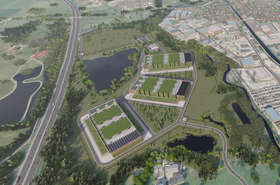The University of Bristol has announced plans to develop a National AI Data Facility to support large-scale data processing efforts.
The multi-million-pound data repository will be housed at the National Composites Centre (NCC) at the Bristol and Bath Science Park, next to the UK’s Isambard-AI supercomputer.
The new facility will allow Isambard-AI to process data with different formats, governance, and access restrictions from across multiple sites. It forms part of the UK government’s AI for Science Strategy, which includes building large-scale data infrastructure that can support AI-driven scientific research.
Launched in July 2025, the 5MW, £225 million ($296m) Isambard-AI supercomputer was built by HPE in partnership with Nvidia and the University of Bristol. It boasts 23 exaflops of AI performance (278 petaflops peak linpak) and ranked 11th on the most recent edition of the Top500 list of the world’s most powerful supercomputers.
Professor Evelyn Welch, vice-chancellor and president of the University of Bristol, said: “As a research-intensive university at the heart of the UK’s AI revolution, we support the announcement of the AI for Science Strategy and are pleased to be a key part of this.
“The National AI Data Facility will be a critical part of its infrastructure, further establishing Bristol and the UK as an international hub for AI research. This investment will be central to creating a ‘British Library’ for the AI age.”
The government also announced this week it would be investing in additional storage capacity at the Edinburgh Parallel Computing Centre (EPCC) – the UK’s first National Supercomputing Centre and site of the UK’s next national supercomputer.
Oxford University’s Exeter College plans new HPC campus
Exeter College at the University of Oxford is planning to build a science park, which will house multiple data centers to support supercomputing infrastructure.
Dubbed EXOq, the 30-hectare site located near Oxford Parkway Station, the high-performance compute (HPC) infrastructure will be made available to researchers from Oxford at a discounted rate.
According to local news outlet Cherwell, just under half of the land will be used as parkland to provide “leisure and community facilities” to local residents. Exeter College will also build new foot and cycle bridges near Oxford Parkway Station, to support travel to Oxford and Kidlington, with heat generated by the data centers to be fed into a district heating system in the city, the report added.
The HPC infrastructure deployed at the site will support research into health, robotics, particle physics, and climate research. The data centers are also expected to include trusted research environments capable of hosting sensitive datasets, such as health data from the NHS.
However, despite the promise that the campus will create jobs in the region, the decision to build it on green belt land has raised concerns amongst local residents and councillors. A report from the BBC quoted The Campaign to Protect Rural England, which said it “strongly” opposed the development.
“Not only is the green belt the countryside next door for over 166,000 Oxford residents, providing numerous mental and physical health benefits, but green belt land also plays a crucial role in nature recovery, climate mitigation and adaptation, as well as contributing to local food security,” it said in a statement.
Read the orginal article: https://www.datacenterdynamics.com/en/news/university-of-bristol-to-build-data-processing-facility-next-door-to-isambard-ai/









